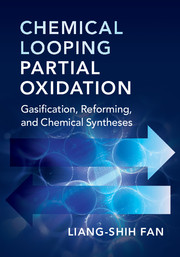Book contents
- Frontmatter
- Dedication
- Epigraph
- Contents
- In Cooperation with Professor Fan's Research Group Members
- Preface
- Nomenclature
- Abbreviations
- 1 Overview
- 2 Metal Oxide Oxygen Carriers
- 3 Oxidative Coupling of Methane
- 4 Syngas Generation
- 5 Catalytic Metal Oxides and Applications
- 6 Process Simulations and Techno-Economic Analyses
- Index
- Color plate section
6 - Process Simulations and Techno-Economic Analyses
Published online by Cambridge University Press: 07 November 2017
- Frontmatter
- Dedication
- Epigraph
- Contents
- In Cooperation with Professor Fan's Research Group Members
- Preface
- Nomenclature
- Abbreviations
- 1 Overview
- 2 Metal Oxide Oxygen Carriers
- 3 Oxidative Coupling of Methane
- 4 Syngas Generation
- 5 Catalytic Metal Oxides and Applications
- 6 Process Simulations and Techno-Economic Analyses
- Index
- Color plate section
Summary
Introduction
A process simulation is the representation of a thermal or chemical transformation by a mathematical model that is solved to provide information about mass and energy requirements, equipment performance, and overall process feasibility. They are system level models used for economic calculations, energy efficiency analyses, and process comparisons. Component level information such as reactor geometry, mixing and hydrodynamics, and transport phenomena, as well as molecular level information such as surface area, reaction mechanism, and electronic interactions, are not included. Beginning with FlowTran, developed by Monsanto in the 1950s and 1960s, several process simulation software packages have since been developed, including ProSim, PRO/II, gPROMS, ChemCAD, and Aspen Plus®, and they play an important role in process development by allowing for the evaluation of a commercial scale plant based on available experimental results.
The process simulation software that is used extensively throughout academic research and industrial operations is Aspen Plus®. Aspen was developed in the late 1970s at Massachusetts Institute of Technology for the United States Energy Research and Development Administration (now United States Department of Energy or USDOE). The project objective was to develop a computer program to aid in performing process evaluations; mainly process economics. Today, Aspen has evolved into Aspen Plus® and, as part of the AspenOne package software suite, has become the essential plant and process design software program. Aspen Plus® provides complete flexibility in designing a process simulation. Every new process begins by specifying the component species and the property method used for calculating the component species thermodynamic properties. Together, these two required specifications display the strength of the Aspen Plus® software program, due to its extensive chemical databank, available methods for calculating thermodynamic properties, and ability to adjust property values when necessary. Once the component species and property methods have been selected, Aspen Plus® assumes control and calculates the thermodynamic properties based on user input, and only allows the inputs required to satisfy the degrees of freedom. The chemical looping partial oxidation examples and the results presented in this chapter were obtained using Aspen Plus® (AspenTech), and they are available on the website as supplemental material.
- Type
- Chapter
- Information
- Chemical Looping Partial OxidationGasification, Reforming, and Chemical Syntheses, pp. 370 - 439Publisher: Cambridge University PressPrint publication year: 2017



